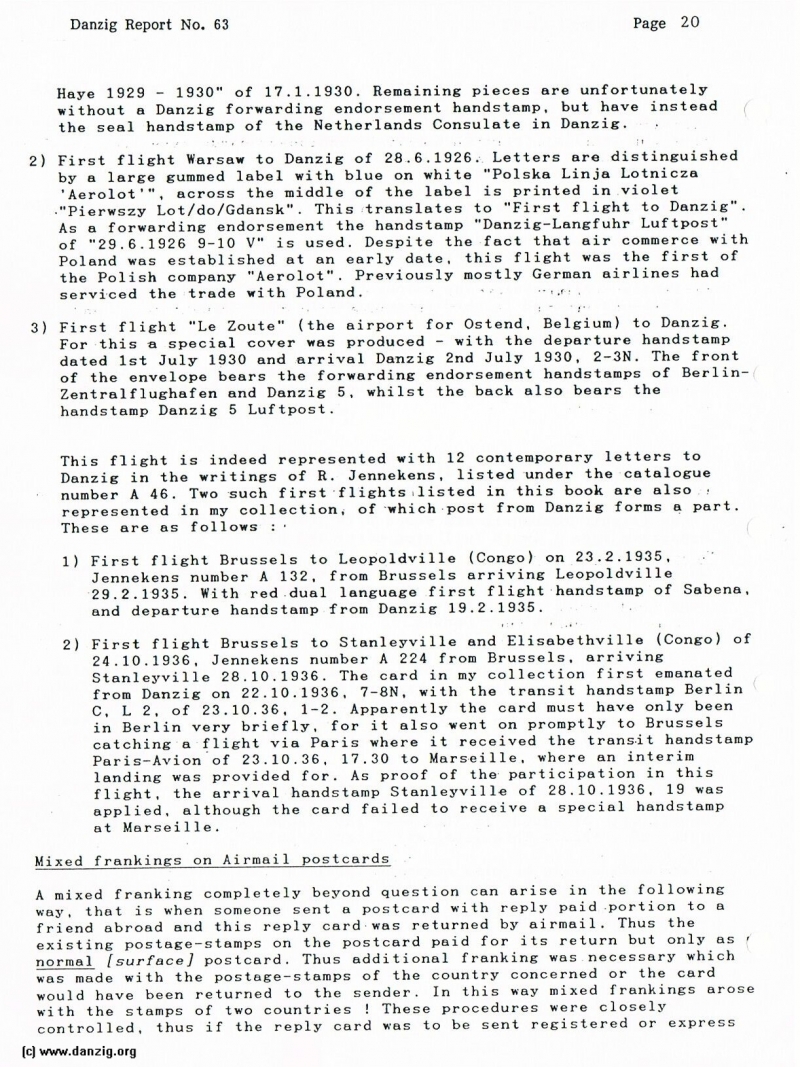
Haye 1929 - 1930” of 17.1.1930. Remaining pieces are unfortunately without a Danzig forwarding endorsement handstamp, but have instead the seal handstamp of the Netherlands Consulate in Danzig.
2) First flight Warsaw to Danzig of 28.6.1926. Letters are distinguished by a large gummed label with blue on white “Polska Linja Lotnicza ‘Aerolot’”, across the middle of the label is printed in violet .“Pierwszy Lot/do/Gdansk”. This translates to “First flight to Danzig”. As a forwarding endorsement the handstamp “Danzig-Langfuhr Luftpost” of “29.6.1926 9—10 V” is used. Despite the fact that air commerce with Poland was established at an early date, this flight was the first of the Polish company “Aerolot”. Previously mostly German airlines had serviced the trade with Poland.
3) First flight “Le Zoute” (the airport for Ostend, Belgium) to Danzig. For this a special cover was produced — with the departure handstamp dated 1st July 1930 and arrival Danzig 2nd July 1930, 2—3N. The front of the envelope bears the forwarding endorsement handstamps of Berlin— Zentraiflughafen and Danzig 5, whilst the back also bears the handstamp Danzig 5 Luftpost.
This flight is indeed represented with 12 contemporary letters to Danzig in the writings of R. Jennekens, listed under the catalogue number A 46. Two such first flights listed in this book are also represented in my collection, of which post from Danzig forms a part. These are as follows
1) First flight Brussels to Leopoidville (Congo) on 23.2.1935. Jennekens number A 132. from Brussels arriving Leopoldville 29.2.1935. With red dual language first flight handstamp of Sabena, and departure handstamp from Danzig 19.2.1935.
2) First flight Brussels to Stanleyville and Elisabethville (Congo) of 24.10.1936, Jennekens number A 224 from Brussels, arriving Stanleyville 28.10.1936. The card in my collection first emanated from Danzig on 22.10.1936, 7-8N, with the transit handstamp Berlin C, L 2, of 23.10.36, 1-2. Apparently the card must have only been in Berlin very briefly, for it also went on promptly to Brussels catching a flight via Paris where it received the transit handstamp Paris—Avion of 23.10.36, 17.30 to Marseille. where an interim landing was provided for. As proof of the participation in this flight, the arrival handstamp Stanleyville of 28.10.1936, 19 was applied, although the card failed to receive a special handstamp at Marseille.
Mixed frankings on Airmail postcards
A mixed franking completely beyond question can arise in the following way, that is when someone sent a postcard with reply paid portion to a friend abroad and this reply cardwas returned by airmail. Thus the existing postage—stamps on the postcard paid for its return but only as normal [surface] postcard. Thus additional franking was necessary which was made with the postage—stamps of the country concerned or the card would have been returned to the sender. In this way mixed frankings arose with the stamps of two countries ! These procedures were closely controlled, thus if the reply card was to be sent registered or express
Danzig Report Vol. 1 - Nr. 63 - April - May - June - 1989, Page 20.
Hits: 3682
Added: 27/06/2015
Copyright: 2025 Danzig.org

